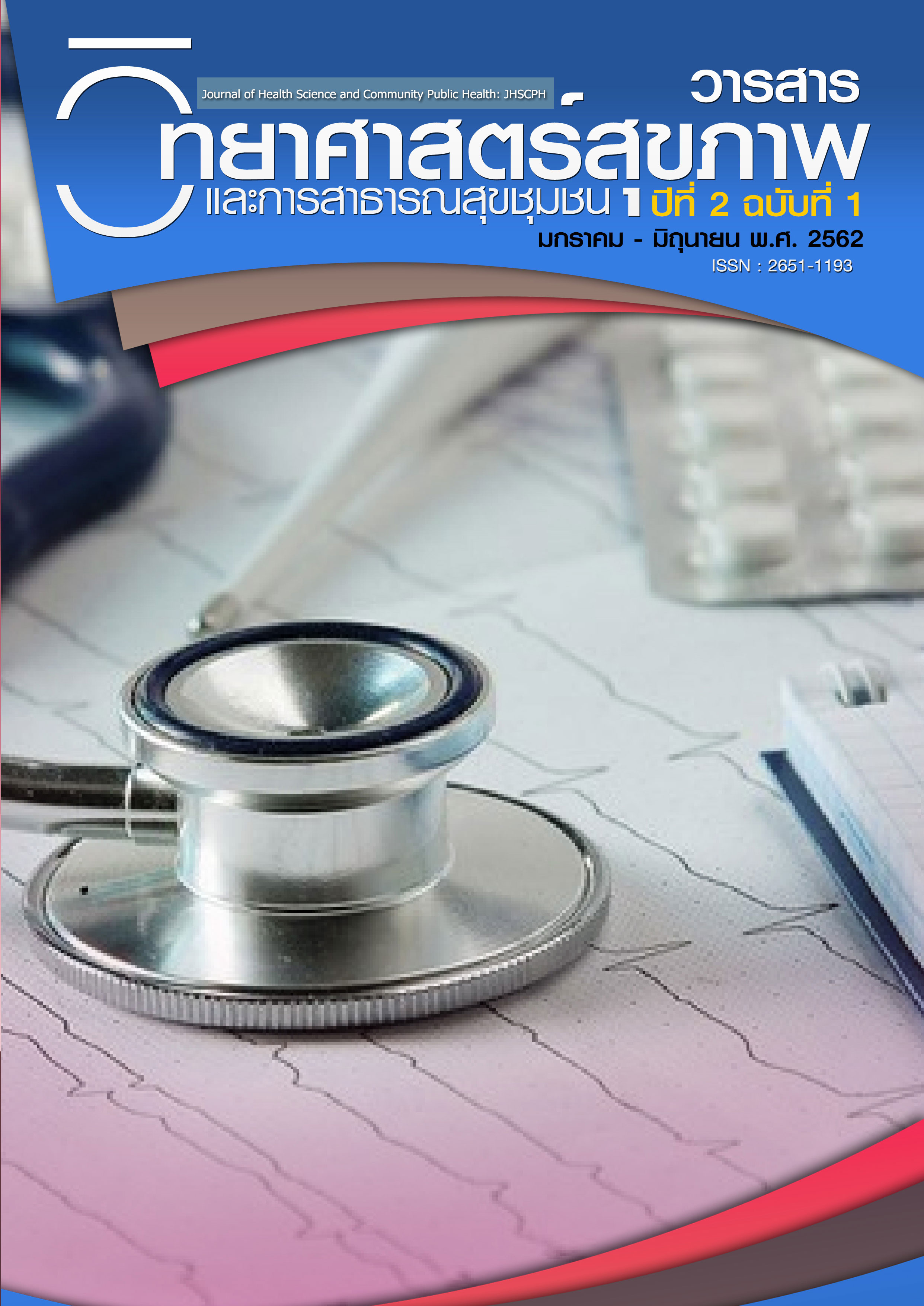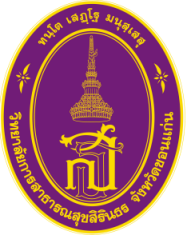กิจกรรมทางกายเพื่อสุขภาพผู้สูงอายุ ยุค 4.0
คำสำคัญ:
การเสียชีวิต, ความสามารถในการทำงานของร่างกาย, การออกกำลังกายบทคัดย่อ
มีประชากรโลกเสียชีวิตประมาณ 3.2 ล้านคนต่อปี เนื่องจากขาดการมีกิจกรรมทางกาย ซึ่งมีผลกระทบต่อสมรรถภาพทางกายที่สัมพันธ์กับสุขภาพและการมีสุขภาพที่ดีของผู้สูงอายุ การเพิ่มระดับของกิจกรรมทางกายมีความสำคัญต่อการพัฒนาสุขภาพและการมีอายุที่ยืนยาวขึ้นของผู้สูงอายุ ซึ่งผลของการเพิ่มระดับของกิจกรรมทางกายสามารถช่วยลดการเสียชีวิตและปัจจัยเสี่ยงของการเกิดโรคต่าง ๆ ในผู้สูงอายุได้ โดยมีข้อแนะนำในการเพิ่มของระดับกิจกรรมทางกายเพื่อสุขภาพสำหรับผู้สูงอายุคือผู้สูงอายุควรมีการออกกำลังกายแบบแอโรบิกที่ระดับความหนักปานกลาง เป็นเวลาอย่างน้อย 30 นาทีต่อวัน 5 วันต่อสัปดาห์ และควรออกกำลังกายแบบแอโรบิกควบคู่กับการฝึกความแข็งแรงของกล้ามเนื้อ เป็นเวลา 2 วันต่อสัปดาห์ ซึ่งการออกกำลังกายที่ความหนักปานกลางเป็นประจำและมีประสิทธิภาพจะสามารถช่วยป้องกันการลื่นล้มและการสูญเสียทางความคิดของผู้สูงอายุได้อีกด้วย ดังนั้น ควรช่วยกันส่งเสริมให้ผู้สูงอายุเพิ่มระดับของกิจกรรมทางกายและสามารถบรรลุและคงรักษาระดับของกิจกรรมทางกายเพื่อเป็นประโยชน์ต่อสุขภาพของผู้สูงอายุเอง
เอกสารอ้างอิง
Bauman A, Craig C. The place of physical activity in the WHO Global Strategy on Diet and physical activity. Int J Behav Nutr Phys Act 2005;2:10.
Paterson D, Jones G, Rice C. Ageing and physical activity: evidence to develop exercise recommendations for older adults. Appl Physiol Nutr Metab 2007;32(Suppl 2E):S69–108.
Blair S, Sallis R, Hutber A, et al. Exercise therapy—the public health message. Scand J Med Sci Sports 2012;22:e24–8.
World Health Organization. Global recommendations on physical activity for health. Geneva: World Health Organization, 2010.
Sakuma K, Yamaguchi A. Sarcopenia and age-related endocrine function. Int J Endocrinol 2012;2012(Article ID 127362):10.
Salthouse TA. Memory aging from 18 to 80. Alzheimer Dis Assoc Disord 2003;17:162–7.
Denise T. Physical activity is medicine for older adults. Postgrad Med J 2014;90:26-31.
Chodzko-Zajko WJ, Proctor D, Fiatarone Singh M, et al. American College of Sports Medicine position stand. Exercise and physical activity for older adults. Med Sci Sports Exerc 2009;41:1510–30.
Ministry of Health. Guidelines on physical activity for older people (aged 65 years and over). Wellington: Ministry of Health, 2013.
Latham N, Liu CJ. Strength training in older adults: the benefits for osteoarthritis. Clin Geriatr Med 2010;26:445–59.
Liu C, Latham N. Progressive resistance strength training for improving physical function in older adults. Cochrane Database Syst Rev 2009;(3):CD002759.
Sherrington C, Whitney JC, Lord SR, et al. Effective exercise for the prevention of falls: a systematic review and meta-analysis. J Am Geriatr Soc 2008;56:2234–43.
Taylor D, Hale L, Schluter P, et al. Effectiveness of Tai Chi as a community-based falls prevention intervention: a randomized controlled trial. J Am Geriatr Soc 2012;60:841–8.
Tremblay M, Esliger D, Tremblay A, et al. Incidental movement, lifestyle-embedded activity and sleep: new frontiers in physical activity assessment. Can J Public Health 2007;98(Suppl 2):S208–17.
Ross R, McGuire KA. Incidental physical activity is positively associated with cardiorespiratory fitness. Med Sci Sports Exerc 2011;43:2189–94.
McGuire KA, Ross R. Incidental physical activity and sedentary behavior are not associated with abdominal adipose tissue in inactive adults. Obesity 2012;20:576–82.
Oguma Y, Shinoda-Tagawa T. Physical activity decreases cardiovascular disease risk in women: review and meta-analysis. Am J Prev Med 2004;26:407–18.
Gregg EW, Cauley J, Stone K, et al. Relationship of changes in physical activity and mortality among older women. JAMA 2003;289:2379–86.
Schultz A. Muscle function and mobility biomechanics in the elderly: an overview of some recent research. J Gerontol Biol Sci Med Sci A 1995;50:60–3.
Paterson D, Warburton D. Physical activity and functional limitations in older adults: a systematic review related to Canada’s physical activity guidelines. Int J Behav Nutr Phys Act 2010;7:38.
Vincent HK, Raiser SN, Vincent KR. The aging musculoskeletal system and obesity-related considerations with exercise. Ageing Res Rev 2012;11:361–73.
Brazzelli M, Saunders DH, Greig CA, et al. Physical fitness training for stroke patients. Cochrane Database Syst Rev 2011;(11):CD003316.
Townsend N, Bhatnagar P, Wickramasinghe K, et al. Physical activity statistics 2012. London: British Heart Foundation, 2012.
O’Neill K, Reid G. Perceived barriers to physical activity by older adults. Can J Public Health 1991;82:392–6.
Schutzer KA, Graves BS. Barriers and motivations to exercise in older adults. Prev Med 2004;39:1056–61.
Lee DC, Sui X, Ortega FB, et al. Comparisons of leisure-time physical activity and cardiorespiratory fitness as predictors of all-cause mortality in men and women. Br J Sports Med 2011;45:504–10.
Pearce JR, Maddison R. Do enhancements to the urban built environment improve physical activity levels among socially disadvantaged populations? Int J Equity Health 2011;10:28.
Coronini-Cronberg S, Millett C, Laverty A, et al. The impact of a free older persons’ bus pass on active travel and regular walking in England. Am J Public Health 2012;102:2141–8.
Landi F, Cesari M, Onder G, et al. Physical activity and mortality in frail, community-living elderly patients. J Gerontol A Biol Sci Med Sci 2004;59A:833–7.
Tak E, Kuiper R, Chorus A, et al. Prevention of onset and progression of basic ADL disability by physical activity in community dwelling older adults: a meta-analysis. Ageing Res Rev 2013;12:329–38.
Knight JA. Physical inactivity: associated diseases and disorders. Ann Clin Lab Sci 2012;42:320–37.
Chou CH, Hwang CL, Wu YT. Effect of exercise on physical function, daily living activities, and quality of life in the frail older adults: a meta-analysis. Arch Phys Med Rehabil 2012;93:237–44.
de Vries NM, van Ravensberg CD, Hobbelen JS, et al. Effects of physical exercise therapy on mobility, physical functioning, physical activity and quality of life in community-dwelling older adults with impaired mobility, physical disability and/or multi-morbidity: a meta-analysis. Ageing Res Rev 2012;11:136–49.
Bandura A. Self-efficacy: toward a unifying theory of behavioral change. Psychol Rev 1977;84:191–215.
Finkelstein EA, Brown DS, Brown DR, et al. A randomized study of financial incentives to increase physical activity among sedentary older adults. Prev Med 2008;47:182–7.
Angevaren M, Aufdemkampe G, Verhaar H, et al. Physical activity and enhanced fitness to improve cognitive function in older people without known cognitive impairment. Cochrane Database of Sys Rev 2008;(3):CD005381.
Geda YE, Roberts RO, Knopman DS, et al. Physical exercise, aging, and mild cognitive impairment a population-based study. Arch Neurol 2010;67:80–6.
Smith PJ, Blumenthal JA, Hoffman BM, et al. Aerobic exercise and neurocognitive performance: a meta-analytic review of randomized controlled trials. Psychosom Med 2010;72:239–52.
เผยแพร่แล้ว
รูปแบบการอ้างอิง
ฉบับ
ประเภทบทความ
สัญญาอนุญาต
บทความที่ได้รับการตีพิมพ์เป็นลิขสิทธิ์ของวารสารวิทยาศาสตร์สุขภาพและการสาธารณสุขชุมชน (Journal of Health Science and Community Public Health) ข้อความที่ปรากฏในบทความแต่ละเรื่องในวารสารวิชาการเล่มนี้เป็นความคิดเห็นส่วนตัวของผู้เขียนแต่ละท่านไม่เกี่ยวข้องกับวิทยาลัยการ สาธารณสุขสิรินธรจังหวัดขอนแก่น และคณาจารย์ท่านอื่นๆในวิทยาลัยฯ แต่อย่างใด ความรับผิดชอบองค์ประกอบทั้งหมดของบทความแต่ละเรื่องเป็นของผู้เขียนแต่ละท่าน หากมีความผิดพลาดใดๆ ผู้เขียนแต่ละท่านจะรับผิดชอบบทความของตนเองแต่ผู้เดียว






